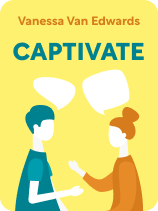

This article is an excerpt from the Shortform book guide to "Captivate" by Vanessa Van Edwards. Shortform has the world's best summaries and analyses of books you should be reading.
Like this article? Sign up for a free trial here.
Do you want to learn how to be more likable and memorable with people you meet? How might your life be different if you could win people over like never before?
Vanessa Van Edwards is a self-proclaimed “recovering awkward person.” She’s also a TEDx Talk presenter and blogger on how to master interpersonal skills. She’s developed strategies to make yourself magnetic, and she shares them in her book Captivate.
Keep reading for five strategies from Van Edwards that will make people like and remember you.
How to Be More Likable & Memorable
Let’s look at Van Edwards’s advice on how to be more likable and memorable by establishing trust, initiating meaningful conversations, being interested to be interesting, highlighting shared connections, and being your authentic self.
#1: Establish Trust
Van Edwards asserts that people decide whether they trust and like us before we even speak, so it’s critical to make both happen immediately. She says you can increase the likelihood of a positive first interaction by making three simple adjustments to your physical behavior:
- Use your hands to demonstrate that you’re trustworthy. Keep your hands visible to show that you’re not hiding anything, gesture to show your intent, and give a firm handshake, which releases the connection hormone, oxytocin.
- Stand up straight with your shoulders back and chest out to project confidence.
- Maintain eye contact in 60 to 70 percent of your interactions to cultivate trust, demonstrate your interest in the other person, and produce oxytocin.
| Use Gestures and Eye Contact Effectively Van Edwards doesn’t specify the order in which you should establish trust and likability; however, body language expert Carol Kinsey Goman argues that when you’re giving a public presentation, you must first establish trust with your audience or it’ll be nearly impossible to get your message across to them—it’s not enough for the audience to simply like you. She builds on Van Edwards’s assertion that hand gestures play a critical role in garnering people’s trust, stating that your hand gestures and what you’re saying must be perfectly aligned for people to trust you. If the two are out of sync, people will subconsciously perceive deceit or uncertainty in you. For example, you can signal candor and openness by showing and tilting your palms at a 45-degree angle or demonstrate certainty by rotating your palms down. If you’re looking to center and ground yourself and your audience, keep your arms bent at a 45-degree angle and gesture within that horizontal plane while adopting a shoulder-width stance. In addition to building trust through hand gestures, Van Edwards recommends making physical adjustments to your body to project confidence—a strategy worth employing not just because it makes you more likable, but because it leads to physiological changes that make you feel better by increasing testosterone and decreasing the chemical associated with stress and anxiety. Finally, as you work to project trust and likability through physical adjustments, be mindful that making and holding eye contact can build trust in some situations but have negative connotations in others. For example, research shows that if you’re negotiating with someone, looking directly into their eyes can be perceived as a sign of competition and deceit. There are cultural considerations, as well: For example, making direct eye contact in some East Asian countries, such as Japan, is considered disrespectful. |
#2: Initiate Meaningful Conversations
Van Edwards asserts that, to make others like and remember you, you have to break out of the boring small talk mold and ignite interesting conversations that push people to think of new and different things.
To start novel conversations, you can ask questions that 1) people don’t expect, shake them out of their rut, and 2) engage people by prompting them to talk about subjects they love and are excited to talk about. For example, “What’s the most exciting thing that happened to you today?” or “What’s the one thing you’re most looking forward to doing this year?”
Van Edwards says that telling interesting stories will enable you to deepen your engagement and forge connections with others. She says that great stories are no more than two to three minutes long and have three parts: a hook to grab attention, a problem that must be solved, and words that describe and excite.
She recommends the following three-pronged approach for introducing and using stories to engage and fuel further conversation with people:
- Build off of a frequently discussed subject.
- Tell a funny or quirky story related to that subject.
- End with a transition sentence or question that connects your story back to the person you’re talking with.
Van Edwards suggests having a stash of stories and questions on hand for different subjects that typically come up in casual conversation.
#3: Be Interested to Be Interesting
Van Edwards asserts that, when you’re genuinely interested in other people, they find you interesting. When you make people feel good, they’ll like and remember you. You can make people feel good in three ways:
- Engage them in conversation.
- Encourage them to talk about themselves.
- Elevate them by boosting their strong points.
She says you can reinforce the positive engage, encourage, and elevate loop by:
- Asking people questions that get them to talk about themselves
- Being an active listener
- Pointing out people’s positive qualities, showing enthusiasm when they’re excited, and bragging about them when you introduce them to others
#4: Highlight Shared Connections
Finding your similarities with others makes you more appealing to them.
You can take the following steps to identify and illuminate your similarities with others:
- Find out if you share friends or interests or if you are engaged in any of the same groups.
- Ask why the friend, interest, or group you have in common matters to the other person. (Van Edwards suggests asking “why?” repeatedly as a way to probe deeper and enrich your understanding of the person.)
- Offer to help or be a resource for the other person if 1) you feel you’ve developed a genuine connection with them and 2) you have something useful you can provide them.
#5: Be Your Authentic Self
Van Edwards asserts that, when you show your true self by being vulnerable, other people find you more likable, human, and relatable. She acknowledges that it can be hard to be vulnerable because nobody likes making mistakes and looking silly in front of other people. However, Van Edwards cites research that shows the following:
- We’re more aware of our flaws than other people because our self-centeredness gives us a distorted perception of what others think of us.
- Making mistakes causes others to see us as more likable and attractive.
Van Edwards recommends you show people your vulnerability by asking others for guidance, which lets them know that you don’t have the answers to everything, gives them a chance to share their expertise (which people like), and allows you to learn more about them. She also says you can be vulnerable by apologizing when you’re wrong, asking for forgiveness, and requesting and accepting small favors. For example, allow someone to treat you to a meal after sharing that you’ve had a tough week.
(Shortform note: In The Power of Vulnerability, Brené Brown argues that being vulnerable breaks down your emotional walls while increasing your empathy and creativity. She also says that vulnerability is essential to building trust between two people because you can’t understand another person’s motives, personality, or feelings without it.)

———End of Preview———
Like what you just read? Read the rest of the world's best book summary and analysis of Vanessa Van Edwards's "Captivate" at Shortform.
Here's what you'll find in our full Captivate summary:
- How socially awkward people can become social superstars
- How to make yourself likable and memorable
- Methods to establish and improve relationships with others






